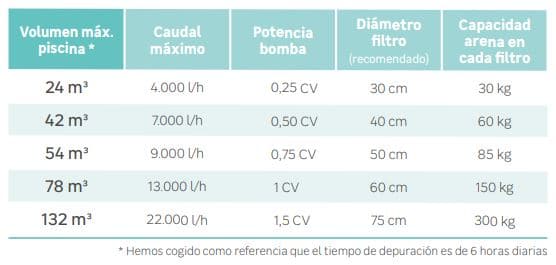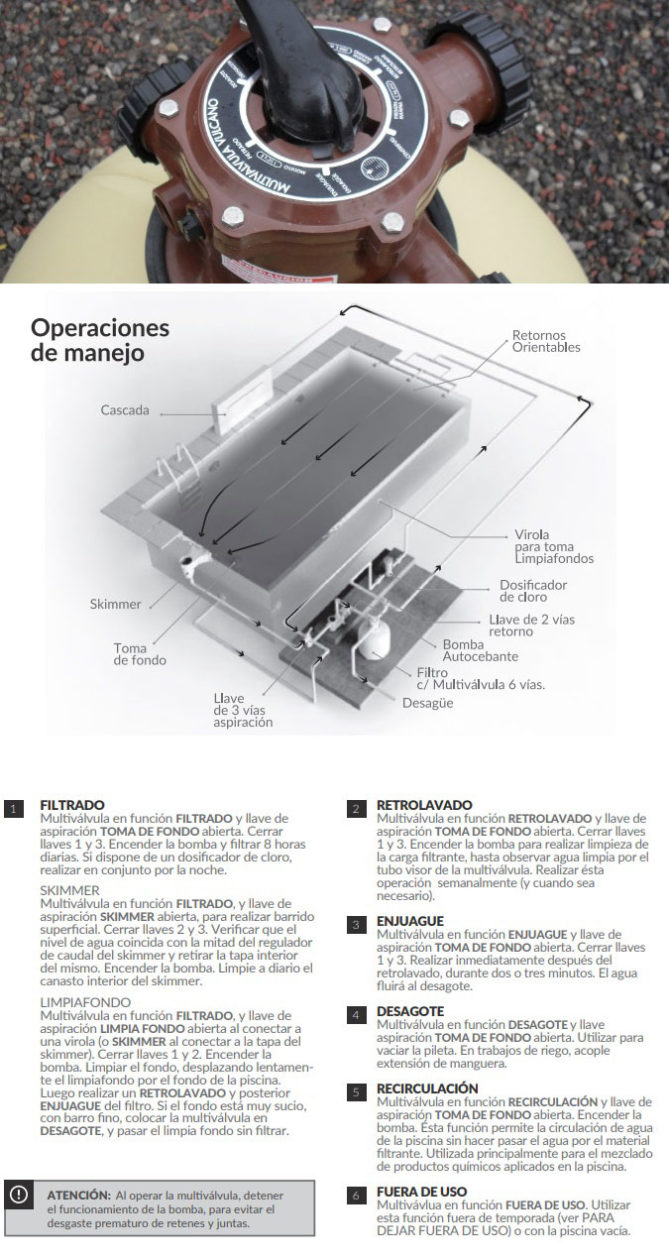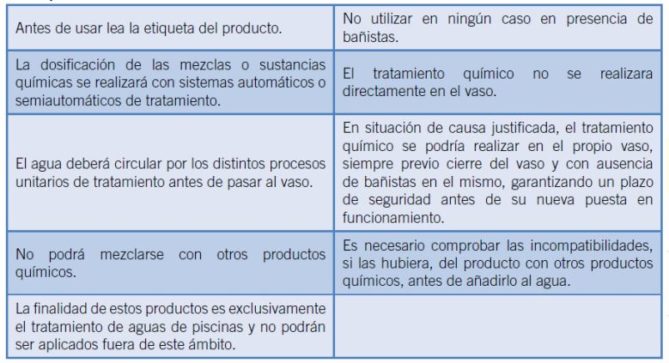-
Phone Number
-
Email Address
In the summer, almost all of us enjoy our baths and dips in some kind of pond, artificial or not, but... so that the amusement does not turn into disgust, it is maintenance of the pool is necessary before, during and after use, without waiting for the latter time, since water is an ideal medium for reproduction bacteria, fungi and microorganisms responsible for diseases and infections that can worsen.
In this reference guide we will see everything necessary to understand how to clean a pool ( Referred to as Alberca in Mexico or Pileta in Argentina ), your products, hygiene, purification theme and accessories to be able to enjoy it properly reviewing the points highlights of the maintenance that you should have throughout all year round, summer or winter.
And remember, we have an article with the most originals that will undoubtedly surprise you!
Content menu:
We cannot practice disinfection and hygiene of a swimming pool or a swimming pool if we do not know the system that does work and volume, at least, in schematic mode. So we left a small drawing that reflects the system of standard operation of the traditional swimming pools that anyone can have installed in his garden:
At the facility, the flow of the pool water it will be sucked by the pump, it will pass through the filter (Removal of external elements such as leaves and impurities), later by the electrolytic cell (This mechanism is not always is) where the electrolysis process occurs and finally the disinfected water returns to the glass.
This aspect is important to be able to choose the treatment tailored to the chemicals to be applied, the pump necessary, filters and skimmers. In the following scheme we can test how to calculate the liters of a swimming pool rectangular, oval or round :
Remember that the result will be in cubic meters of water, that is to say… How many liters fit in the glass? It doesn't matter if it is from a fiberglass pool and polyester resin, smooth concrete with typical tiles of colors, the value will be the same for the models of:
Total liters of water = (Our data Calculated volume) m3 x 1,000 Liters/m3 = Total liters of water in the pool .
And at this point, it's time to see how to clean a swimming pool and what do we have to take into account…
In this section we provide a diagram and explain the steps to take, whether you have practiced the « winter storage» (Referring to the chemical treatment to maintain the pool during the winter ), Otherwise, the tasks would be:
Right now you're probably thinking, why do I have to bother scrubbing or cleaning when I add bleach or other sanitizing chemicals in water? It is a question valid, and we have an answer.
Think of it this way. When you shower, you use shampoo and soap, which are cleaning agents. But does your bathtub hold clean indefinitely? Of course not. The shampoo and the soap are to clean your body, not tiles, tiles, porcelain or fiberglass. In the cleaning of swimming pools , the same thing happens.
Chemicals will not keep leaves and insects out of the water, nor will they keep clean indefinitely the walls and the floor. So no excuses.
In addition to using chlorine or other chemical products to keep the pool cleanliness , it is also absolutely necessary practice regular disinfection and complete of the construction itself.
In the setting up of a small pool or large, there are a series of steps that we should check and practice consistently:
In a more complete way with images we see how cleaning pools step by step:
Now, touch the facilities…
The filtration system in a swimming pool It is not that complicated either but we must understand the function of each element; Skimmers, sump, suction nozzle, delivery nozzles, the pump, the valve, the pre-filter and filter, electrical panel and piping system.
The filtration system consists of various devices that are are in charge of clarifying the water and filtering it, retaining those particles that we do not want to be and returning a water totally clean. The features are:
It must be taken into account that in the maintenance of removable, prefabricated or small pools , not they always present such a complex circulation system. Here play what we have spent in the construction or purchase.
The place and location of the pool – pool . We will have higher maintenance if you are surrounded by trees, grass or sand, that if it is surrounded by cement or wood, or if they are protected with pergolas or enclosed – automatic covers in the garden. (See article terrace enclosures, with useful tips and pergolas in the garden)
The time that the treatment plant will be in march . The proper time would be for us to at least spend all the water twice through the filter during the day. He switching on a treatment plant is usually between 4 and 6 hours a day, if we see impurities and stains, then we will raise it to 7 – 8 hours.
The pump may be the most important element of the entire installation . The amount of water that is capable of aspiring and driving is called «flow» and that it will go in relation to the volume of the pool:

The size of the filter must be in relation to the power of the battery pump as we see in the previous image.
In modern swimming pools we find the valve or 6-way tap next to the filter that controls the different maintenance operations in the circuit; wash, rinse, empty, recirculate or by-pass…etc. To understand how it works we leave the following scheme:

In filter maintenance . One has to keep in mind that the slower the speed of the flow of the water that goes through the filter the better it will be filtering… How to maintain and what to consider when using the filters?

In the circulation of water
Pool cleaners
Water is balanced when it is actually clean. He The following table indicates some practical advice before levels for stable maintenance of your pool :
| The parameters | What is it? | When to analyze | Ideal range |
| pH | A measure of the acidity of water | 2 times a week | 7,2 – 7,6 |
| Free residual chlorine | The amount of active chlorine in the water | Every day | From 0.5 to 2 ppm |
| Total Alkalinity (TA) | The ability of water to maintain pH at a certain level suitable | Once a week | From 60 to 120 ppm |
| Calcium hardness (CH) | The amount of calcium dissolved in the water | Once a week | Acceptable from 200 to 1,000 ppm Ideal: from 200 to 500 ppm |
| Cyanuric acid stabilizer (CYA) | The measurement of the ability of chlorine to be protected from the ultraviolet rays of the sun (these rays reduce chlorine in pool water) | Twice a week | Ideal range: 20 to 50 ppm Do not exceed 100 ppm |
To clarify the acceptable values in the chemical parameters of water we provide the following table (Remember that these values are indicative and never replace local standards, if they are of app)
IMPORTANT : We provide some advice on the instructions for use and application instructions chemical products for the treatment of swimming pools :

There are some tools that can be useful to us. By example, the following calculator to correct water parameters in relation to the volume of the pool that is simple and effective. we can see it from HERE.

There are also options for mobile phones, but, in Spanish, there are very bit. It is a calculator for swimming pools in simple mode, which for many is enough.
The App for swimming pools SafePool365 is directly one of the best: You can find it in the store for Android and for iOS from HERE.
As we can see in the following image, the settings are simple but we will have a complete vision of how the swimming pool and what solutions we can adopt with this App for swimming pools .
In the following diagram we will see the treatments of most common anomalies and possible corrections or solutions. Remember that there are also professionals or stores specialists who can advise us adequately on a problem.
| Problem | Cause | Solutions |
| High combined chlorine | Poor chlorination. presence of organic matter and nitrogenous compounds (Ammonia) | Adjust chlorine levels. Cleaning the filters. Bathers hygiene. possible treatment of shock Incorporate UV or Ozone |
| Irritation of the eyes and skin skin | pH outside the recommended value. combined chlorine too tall. Presence of organic matter | Adjust to pH 7.2 – 7.6. Reduce chloramines. Possible shock treatment |
| Green colored water | Presence of algae | Clean and remove algae by brushing. Adjust the pH between 7.2-7.6. Shock treatment. Add flocculant and leave filtering for 24 hours. Finally add double amount of algaecide |
| Stains on the walls of the pool | Presence of metal ions normally due to corrosion problems | Scrub and clean stains with a brush and a surface descaler. Adjust the pH Adjust the alkalinity |
| Turbidity | high water pH and alkalinity. Poor Filtration Formation seaweed | Raise the pH to 7.8 Clean the filter. add flocculant and stop the filter 1 hour. Reset pH values and alkalinity. Maintain filtration for 10 hours in a row |
| Formation of foam in the water | Excess algicides. Excess organic matter | Shock treatment and subsequent chlorine adjustment free Adjust the pH Renew part of the water in the pool |
| Incrustations on walls | High concentration of calcium salts-(Hardness) pH too high | Perform a flocculation. Decrease to pH 7.2. Add anti-limescale products. decrease the hardness of the water |
| Brown colored water | Presence of iron or manganese particles | Raise the pH to 7.8. shock chlorination. Add flocculant. Pass the pool cleaner |
| Rusting metal parts | Excessively low pH values. low alkalinity Corrosion occurs metal parts | Adjust the pH to 7.2 – 7.5. Maintain Alkalinity between 60 – 125 mg/l |
| Slippery walls and floors or green | Formation of algae on the walls and floor. Incorrect disinfection | Clean and remove algae by brushing. Adjust the pH between 7.2-7.6. Shock treatment. Add flocculant and leave filtering for 24 hours. Finally, add double amount of algaecide. keep a sanitizer correct residual |
| Low hardness | Supply water. Contribution of chemical products. Pitting on the surface of the glass. Tendency to corrosion | Add calcium chloride |
| High hardness | Supply water. Contribution of chemical products. Filter Blocking Embeds | Replacement of part of the pool water with one of less hardness. you can also get adding chelating or sequestering products that help to keep calcium salts dissolved |
| Low alkalinity | Supply water. Contribution of chemical products pH bass | Add carbonate or sodium bicarbonate to the water. (Alkaline substances) |
| High alkalinity | Supply water. Contribution of chemical products pH tall | Add sodium bisulfite or hydrochloric acid (acid substances) |
In order to minimize the potential for transmission of COVID-19 (Coronavirus) and provide a safe and healthy on the premises. You have to understand that they have implemented different recommendations that, although they are aimed at opening swimming pools for sports use and recreational pools, it is interesting to know them for the field private.
Although according to the CSIC (Consejo Superior de Investigaciones Scientific) it is unlikely to contagion by Covid-19 in the water as outlined in this official document We must be beware!
The reference document and recommendations published by the Ministry of Health is this PDF (We recommend reading it). As a summary and conclusions of the report: